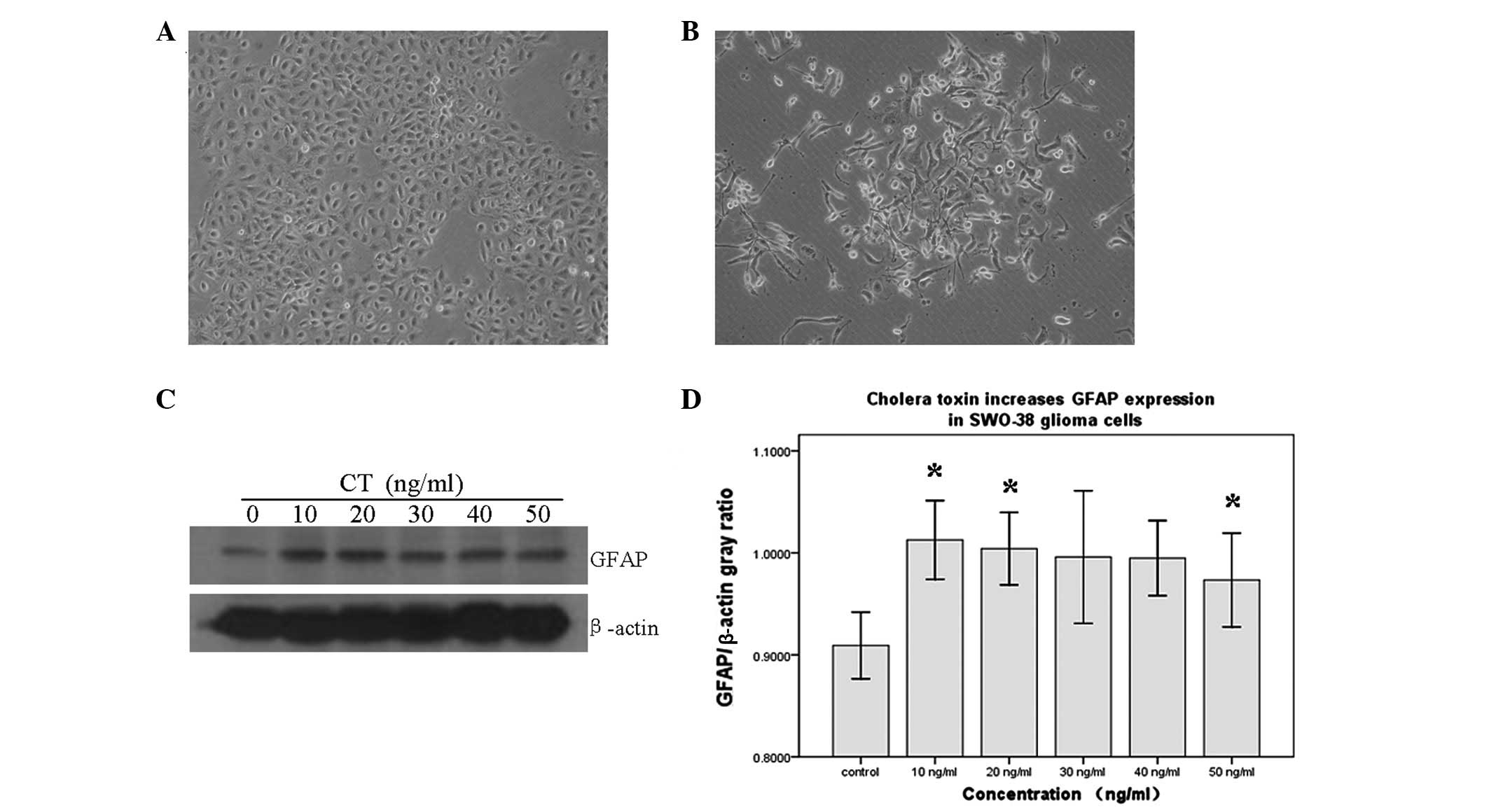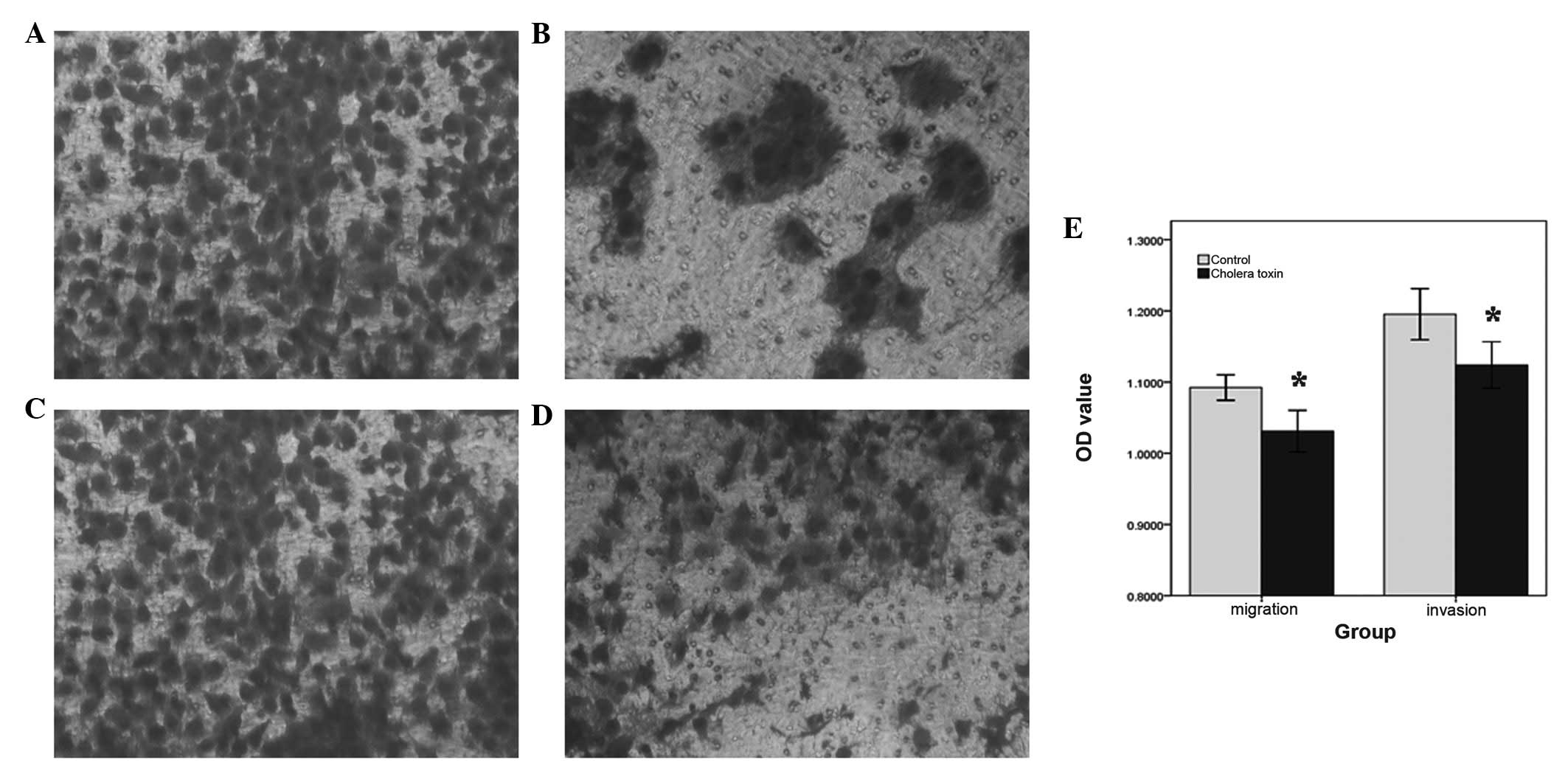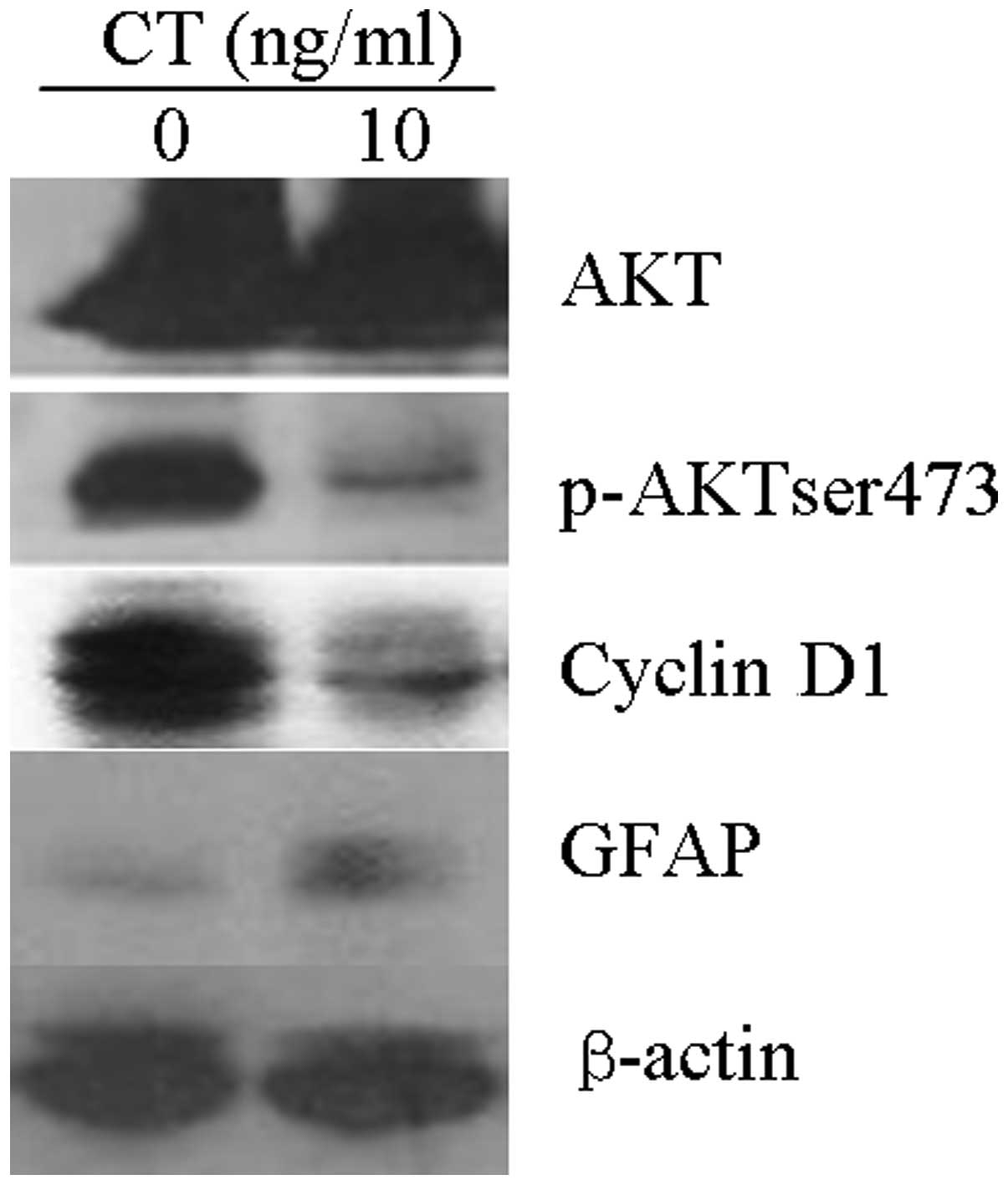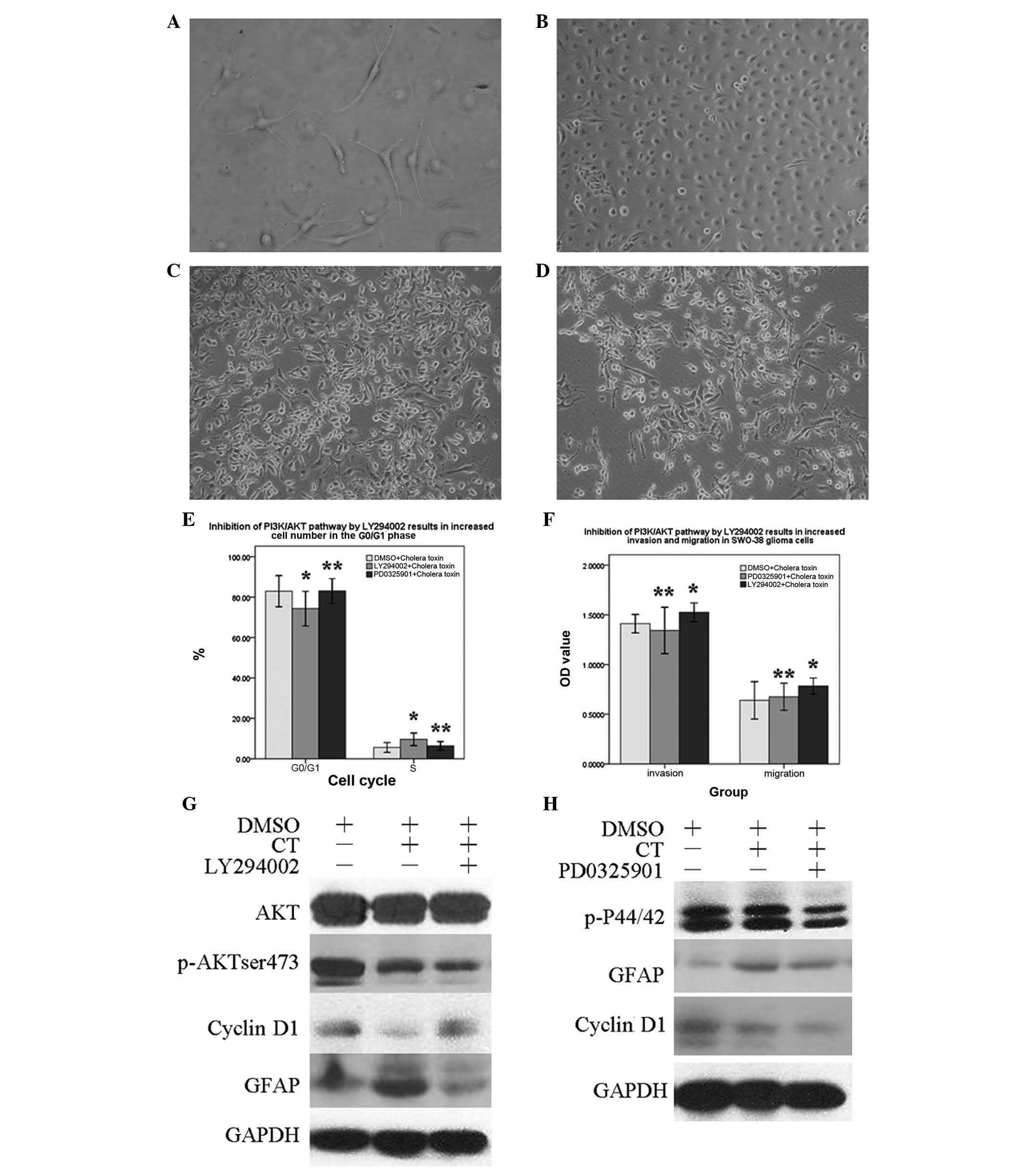Role of PTEN in cholera toxin-induced SWO‑38 glioma cell differentiation
- Authors:
- Published online on: April 18, 2013 https://doi.org/10.3892/mmr.2013.1434
- Pages: 1912-1918
Abstract
Introduction
Gliomas are the most common type of malignant primary brain tumor. Despite advances in neurosurgical resection, radiation therapy and chemotherapy, the prognosis of patients with gliomas has not significantly improved in the last 30 years. The median life expectancy for patients with malignant gliomas is ~12 months and <5% of patients survive for 5 years following diagnosis (1,2). Consequently, investigating methods to improve the efficacy of glioma therapy has become an important issue. Differentiation therapy, which uses agents to induce cancer cell differentiation, has been proposed as a potential novel approach to treat malignant solid tumors (3). Cholera toxin (CT) has been reported to be a differentiation agent that induces the differentiation of malignant gliomas. The underlying mechanisms of CT-induced glioma cell differentiation have been shown to involve the activation of the PKA/cyclic adenosine monophosphate (cAMP)/CREB and PI3K/AKT/GSK3β pathways (4,5). Phosphatase and tensin homolog deleted on chromosome 10 (PTEN) is a commonly mutated tumor suppressor gene in gliomas and is closely associated with glioma tumorigenesis, development and differentiation. However, the underlying mechanisms of PTEN in glioma cell differentiation remain unclear.
In order to understand the mechanisms of PTEN on glioma differentiation, we studied the relationship between PTEN and SWO-38 cell differentiation.
Materials and methods
Cell line
The human glioma cell line SWO-38 was established by the Department of Pathology, Medical College of Jinan University (Guangzhou, China) (6) and grown in RPMI-1640 medium (Invitrogen, Carlsbad, CA, USA) supplemented with 10% newborn bovine serum (TBD Biotechnology Development, Tianjin, China), 100 U/ml penicillin and 100 mg/ml streptomycin. The cells were cultured at 37°C in a humidified incubator with 5% CO2 and were regularly examined using an inverted microscope.
Morphological evaluation
The morphology of CT-treated and untreated cells was investigated during a time course of 48 h using an inverted microscope (TE2000; Nikon Corporation, Tokyo, Japan).
Cell cycle assessment using flow cytometry
SWO-38 cells in culture flasks were treated with 20 ng/ml CT alone for 72 h or pretreated with the MAPK inhibitor PD0325901, the PI3K inhibitor LY294002 or DMSO (as a solvent control) for 2 h. The cells were harvested and washed with PBS. Cells (1×106) were fixed in 70% ethanol at 4°C for 24 h, washed in PBS, resuspended in 0.5–1.0 ml PBS containing 50 mg/ml RNase A at 37°C for 15 min and incubated in 50 mg/ml propidium iodide (PI; Sigma-Aldrich, St. Louis, MO, USA) in the dark at room temperature for 15 min. Flow cytometry was performed using a FACScan flow cytometer (Becton-Dickinson, San Jose, CA, USA).
Cell migration and invasion
Cell migration and invasion capacity was examined using a 24-well Transwell plate with 8-mm pore polycarbonate membrane inserts, according to the manufacturer's instructions (Corning, Inc., Corning, NY, USA). Matrigel (14.8 μg/ml; BD Biosciences, Franklin Lakes, NJ, USA) was employed for the invasion assays and applied to the upper surface of the membranes. Cells (2×105 and 1×105/well for invasion and migration, respectively) were seeded in the top chamber in serum-free media and this was replaced with complete growth media for 20 h for invasion and 12 h for migration. The cells that invaded or migrated through the surface of the membrane were fixed with methanol and stained with 0.1% hexamethylpararosaniline. Migrating or invasive cells from three random microscopic fields for each filter were selected for cell counting.
PTEN silencing in SWO-38 cells using RNA interference
The human PTEN ShortCut siRNA and negative siRNA (control) were purchased from Invitrogen. The coding strand sequence of the PTEN siRNA was sense, 5′-GGCGCUAUGUGUAUUAUUAdTdT-3′ and antisense, 3′-dTdTCCGCGAUACACAUAAUAAU-5′. SWO-38 cells with 30–50% confluence were transfected using Lipofectamine™ 2000 reagent (Invitrogen), according to the manufacturer's instructions. The inhibition of PTEN protein expression was assessed using western blot analysis 6 h after transfection. The cells were then incubated with CT for an additional 72 h for further analysis.
Western blot analysis
Protein samples were prepared with lysis buffer containing 50 mM Tris (pH 8.0), 150 mM NaCl, 1% NP-40, 0.1% SDS, 100 ng/ml phenylmethylsulfonyl fluoride (PMSF) and 1 mg/ml aprotinin. For western blot analysis, equal amounts of proteins were loaded onto 10% SDS-PAGE gels for electrophoresis and then transferred to nitrocellulose membranes (Pall Corporation, Cortland, NY, USA). The nitrocellulose membranes were immediately blocked with 5% non-fat milk in Tris-buffered saline (TBS)-T (0.05% Tween-20 in TBS) buffer for 1 h at room temperature and then incubated overnight at 4°C with primary antibodies against glial fibrillary acidic protein (GFAP; 1:100; LabVision, Fremont, CA, USA), PTEN (1:1,000, Cell Signaling Technology, Inc., Beverly, MA, USA), AKT and p-AKTser473 (1:1,000; Cell Signaling Technology, Inc.), respectively. Following incubation with horseradish peroxidase-labeled secondary antibody at room temperature for 1 h, the membranes were detected using SuperSignal West Pico Chemiluminescent Substrate (Pierce, Rockford, IL, USA). GAPDH (1:4,000; Millipore, Billerica, MA, USA) or β-actin (1:500; Proteintech Group, Chicago, IL, USA) were used to normalize the quantity of protein on the blots.
Statistical analysis
Data are presented as the mean ± standard deviation (SD) from three separate experiments. Statistical analysis was carried out by an independent samples t-test and one-way ANOVA using the statistical package SPSS 16.0. P<0.05 was considered to indicate a statistically significant difference.
Results
CT induces morphological transformation and an increased expression of GFAP in SWO-38 cells
The differentiation of human SWO-38 glioma cells towards an astrocytic type was characterized by a marked morphological transformation from a flat polygonal appearance to multiple elongated cytoplasmic processes, similar to those of mature astrocytes (Fig. 1A and B). Microscopic observation of SWO-38 glioma cells treated with 10 ng/ml CT revealed major alterations in their morphology. We further examined the expression of GFAP, a well-documented marker of mature astrocytes. As shown in Fig. 1C and D, western blot analysis demonstrated a significant upregulation of GFAP protein expression in CT-treated cells compared with the control cells. However, this upregulation was not dose-dependent or time-independent.
CT induces cell cycle arrest in SWO-38 cells
CT induced significant cell cycle arrest in SWO-38 cells. Incubation with 20 ng/ml CT for 72 h caused an accumulation of cells in the G0/G1 phase; the percentage of cells in this phase reached 73.01±2.55% compared with 65.24±3.74% in the control group (Fig. 2A and B). Furthermore, there was a significant decrease in the percentage of cells in the S phase. The percentage of the cells in the S phase was 17.19±2.53% in the CT-treated group and 25.58±3.18% in the control group. Western blot analysis confirmed that treatment with 20 ng/ml CT for 72 h downregulated the cyclin D1 protein levels (Fig. 2C and D). Based on these results, CT appears to block cell-cycle progression from the G1 to the S phase.
CT decreases the migration and invasion capacity of SWO-38 cells
CT-treated SWO-38 cells exhibited a significantly decreased invasion (Fig. 3A and B) and migration (Fig. 3C and D) capacity compared with the control cells (P<0.05; Fig. 3E).
p-AKTser473 activity is decreased in CT-induced SWO-38 glioma cell differentiation
To elucidate the underlying molecular mechanism of CT-induced SWO-38 glioma cell differentiation, we determined the expression of the main proteins involved in the PI3K/AKT signaling pathway. As shown in Fig. 4, p-AKTser473 activity decreased after SWO-38 cells were treated with 10 ng/ml CT for 72 h, whereas the AKT activity was not altered. Additionally, CT treatment upregulated GFAP and downregulated cyclin D1 expression in the SWO-38 cells.
PTEN is requisite for the CT-induced differentiation of SWO-38 cells
To further investigate whether PTEN is required during the process of CT-induced SWO-38 cell differentiation, siRNA was used to selectively knockdown the PTEN gene. After 6 h of transfection, the PTEN level was markedly reduced compared with the control cells (Fig. 5F). After the addition of CT, the cells were incubated for a further 72 h. The differentiation effects of CT on cell morphology (Fig. 5A and B), GFAP expression (Fig. 5F), cell cycle distribution (Fig. 5C and D) and invasion and migration capacity (Fig. 5E) in SWO-38 cells were attenuated.
Inhibition of the PI3K pathway leads to decreased SWO-38 cell differentiation
To provide additional evidence for the importance of the PTEN/PI3K/AKT pathway in SWO-38 cell differentiation, we assessed the effects of the MAPK inhibitor PD0325901 and PI3K inhibitor LY294002 on CT-induced SWO-38 cell differentiation. SWO-38 cells were incubated with LY294002 (100 μmol/l) or PD0325901 (40 μmol/l) for 2 h. CT was subsequently added and the cells were incubated for an additional 72 h. As shown in Fig. 6A and B, CT-induced morphological transformation was attenuated via the inhibition of PI3K activity by LY294002, while exposure to the MAPK inhibitor PD0325901 and CT did not alter PI3K activity (Fig. 6C and D). Furthermore, the upregulation of GFAP and p-AKTser473 and the downregulation of cyclin D1 induced by CT were reverted by LY294002, but not by PD0325901 (Fig. 6G and H). The cell cycle alterations (G0/G1 cell cycle arrest and accelerated S phase entry; Fig. 6E) and cell migration and invasion capacity were markedly counteracted by LY294002, indicating that the PTEN/PI3K/AKT pathway rather than the PTEN/MAPK/ERK pathway was directly involved in the process of differentiation in SWO-38 cells (Fig. 6F).
Discussion
The PTEN gene is an important tumor suppressor which encodes a protein that carries out lipid and protein phosphatase activities. The PTEN gene is one of the most commonly mutated tumor suppressor genes in human tumors (7,8). In gliomas, particularly glioblastomas, mutation of the PTEN gene has been demonstrated to be as high as 70–80% and the mutation rate increases with decreasing tumor differentiation, which indicates that a putative suppressor gene involved in early glial tumorigenesis may exist (9). However, the role and mechanism of PTEN in glioma cell differentiation has not yet been fully elucidated.
CT is the major virulence factor of Vibrio cholerae and a specific agonist of G protein-coupled receptor. CT has been shown to upregulate the level of intracellular cAMP and activate the PKA/CREB signaling pathway, which plays a role in regulating cell proliferation, apoptosis and differentiation (10). The upregulation of the cAMP/PKA/CREB pathway has been revealed as one of the underlying molecular mechanisms that mediates the effect of CT on glioma cell differentiation (4).
In the present study, CT was used as a cell differentiation agent to investigate its effect on the induction of SWO-38 glioma cell differentiation. CT was shown to induce SWO-38 cell differentiation; this was characterized by a morphological transformation from a flat polygonal appearance to multiple elongated cytoplasmic processes, the upregulation of GFAP protein expression, an accumulation of cells in the G0/G1 phase of the cell cycle, the downregulation of cyclin D1 expression and a decrease in invasion and migration capacity. Furthermore, the silencing of PTEN protein using RNA interference resulted in suppressed cell differentiation. This indicates that CT-induced SWO-38 cell differentiation may be associated with PTEN.
The PTEN/PI3K/AKT pathway is involved in the regulation of cell proliferation, differentiation and apoptosis, and PTEN is an important upstream suppressor gene in this pathway. Thus, we hypothesized that the mechanism of action of PTEN in CT-induced SWO-38 cell differentiation may involve the PI3K/AKT pathway. To test this hypothesis, the specific PI3K/AKT pathway inhibitor LY294002 and the specific MAPK/ERK pathway inhibitor PD0325901 were applied to block the two signaling pathways. The previously mentioned indicators of SWO-38 cell differentiation were detected again. Inhibition of the PI3K/AKT pathway by LY294002 was shown to attenuate cell differentiation, whereas differentiation remained stable with the inhibition of the MAPK/ERK pathway by PD0325901. These results confirmed our hypothesis and suggest that PTEN exerts its effect on SWO-38 cell differentiation through lipid phosphatase activity.
Li et al(4,5) previously reported that the cAMP/PKA/CREB pathway and PI3K/AKT/GSK-3β-mediated cyclin D1 ubiquitin-based degradation were the major molecular mechanisms underlying CT-induced glioma cell differentiation (5,11). They also showed that CT-induced SWO-38 glioma cell differentiation involved the PI3K/AKT pathway and PTEN inhibited the PI3K/AKT pathway in this process. Therefore, the cAMP/PKA/CREB and PI3K/AKT pathway may be the major mechanisms of CT-induced glioma cell differentiation (4,12,13).
In conclusion, results of the present study showed that PTEN was involved in CT-induced SWO-38 cell differentiation via its lipid phosphatase activity, which inhibits the PI3K/AKT pathway. However, further investigation is required to fully elucidate the association between CT and PTEN.
Acknowledgements
This study was supported by grants from the National Natural Science Foundation of China (no. 81072059), the National Natural Science Foundation of China for Young Scholars (no. 81101652), the Science and Technology Innovation Key Project of Guangdong Higher Education Institutes (no. CXZD1110), the Natural Science Foundation of Guangdong Province (no. 10151063201000059) and the Natural Science Foundation of Hainan Province, China (no. 309037).
References
|
Das P, Puri T, Jha P, et al: A clinicopathological and molecular analysis of glioblastoma multiforme with long-term survival. J Clin Neurosci. 18:66–70. 2011. View Article : Google Scholar : PubMed/NCBI | |
|
Stupp R, Mason WP, van den Bent MJ, et al; European Organisation for Research and Treatment of Cancer Brain Tumor and Radiotherapy Groups; National Cancer Institute of Canada Clinical Trials Group. Radiotherapy plus concomitant and adjuvant temozolomide for glioblastoma. N Engl J Med. 352:987–996. 2005. View Article : Google Scholar : PubMed/NCBI | |
|
Leszczyniecka M, Roberts T, Dent P, Grant S and Fisher PB: Differentiation therapy of human cancer: basic science and clinical applications. Pharmacol Ther. 90:105–156. 2001. View Article : Google Scholar : PubMed/NCBI | |
|
Li Y, Yin W, Wang X, et al: Cholera toxin induces malignant glioma cell differentiation via the PKA/CREB pathway. Proc Natl Acad Sci USA. 104:13438–13443. 2007. View Article : Google Scholar : PubMed/NCBI | |
|
Li Y, Lu H, Huang Y, et al: Glycogen synthase kinases-3beta controls differentiation of malignant glioma cells. Int J Cancer. 127:1271–1282. 2010. View Article : Google Scholar : PubMed/NCBI | |
|
Situ R, Wang HH, Wang JH, et al: Establishment of human brain malignant glioma cell line (SWO-38) and observation of its biologic properties. Chin J Cancer. 6:235–238. 1987.(In Chinese). | |
|
Li J, Yen C, Liaw D, et al: PTEN, a putative protein tyrosine phosphatase gene mutated in human brain, breast, and prostate cancer. Science. 275:1943–1947. 1997. View Article : Google Scholar : PubMed/NCBI | |
|
Tamura M, Gu J, Matsumoto K, et al: Inhibition of cell migration, spreading, and focal adhesions by tumor suppressor PTEN. Science. 280:1614–1617. 1998. View Article : Google Scholar : PubMed/NCBI | |
|
Ohgaki H and Kleihues P: Genetic pathways to primary and secondary glioblastoma. Am J Pathol. 170:1445–1453. 2007. View Article : Google Scholar : PubMed/NCBI | |
|
Walsh DA and Van Patten SM: Multiple pathway signal transduction by the cAMP-dependent protein kinase. FASEB J. 8:1227–1236. 1994.PubMed/NCBI | |
|
Shu M, Zhou Y, Zhu W, et al: MicroRNA 335 is required for differentiation of malignant glioma cells induced by activation of cAMP/protein kinase A pathway. Mol Pharmacol. 81:292–298. 2012. View Article : Google Scholar : PubMed/NCBI | |
|
Wang L, Liu F and Adamo ML: Cyclic AMP inhibits extracellular signal-regulated kinase and phosphatidylinositol 3-kinase/Akt pathways by inhibiting Rap1. J Biol Chem. 276:37242–37249. 2001. View Article : Google Scholar : PubMed/NCBI | |
|
Downward J: Role of phosphoinositide-3-OH kinase in Ras signaling. Adv Second Messenger Phosphoprotein Res. 31:1–10. 1997. View Article : Google Scholar : PubMed/NCBI |
















